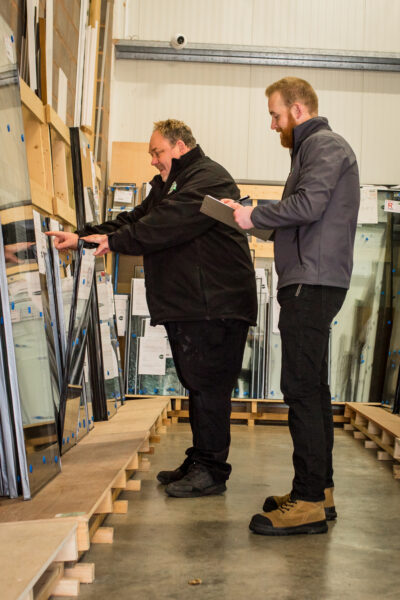
If you've ever had a quote to replace a glass unit you may have noticed the phrase 'Safety Glass'. It may be obvious that it's there for your safety, but how does it work? how is it made? and why is it more expensive compared to standard glass?
Toughened safety glass, also known as tempered glass, is a type of glass that is processed to make it stronger and more durable than regular glass.
Toughened safety glass shatters into small, dull pieces that are less likely to cause injury than sharp large shards of regular glass. It is commonly used in applications where safety and durability are a concern, such as in car windows, shower doors, and in our case, doors and windows that require it.
Safety glass and standard glass differ in their strength, durability, and safety features. Standard glass is made by heating sand, soda ash, and limestone to a high temperature and allowing it to cool slowly. It is a fragile material that breaks easily under pressure and can cause severe injuries when shattered.
On the other hand, safety glass is made by treating standard glass with various processes to enhance its strength and durability. Tempered glass undergoes a process of heating and cooling to create a surface compression that makes it resistant to impact, thermal shock, and temperature changes. If it breaks, it shatters into small, dull pieces that are less likely to cause injury.

Toughened safety glass, also known as tempered glass, is made by a process of controlled thermal treatment. The process involves heating a standard glass pane to a temperature of around 620°C and then rapidly cooling it using a controlled blast of air. This creates a surface compression that makes the glass up to five times stronger than standard glass.
The process of making toughened safety glass involves several steps:
1. Cutting: The glass is cut to the required size and shape.
2. Cleaning: The glass is thoroughly cleaned to remove any dust, dirt, or oil that may be present on its surface.
3. Heating: The glass is heated in a special furnace to a temperature of around 620°C for several minutes.
4. Cooling: The heated glass is then rapidly cooled using a blast of air. This creates a surface compression that makes the glass stronger.
5. Annealing: The glass is then slowly cooled in a process known as annealing. This helps to balance the internal stresses in the glass and reduce the risk of breakage.
The final product is a strong and durable pane of glass that is resistant to impact, thermal shock, and temperature changes.
Toughened safety glass is more expensive than standard glass because it undergoes additional processing steps that increase its strength and durability. The process of thermal treatment used to make toughened glass requires specialized equipment, skilled labour and huge amounts of energy which adds to the production cost.
Another reason why toughened glass is more expensive is that it is less prone to breakage than standard glass. This means that it can be used in high-risk applications where standard glass would be unsafe or unsuitable.
Overall, the increased strength, durability, and safety of toughened safety glass make it a superior option to standard glass in many applications, but these benefits come at a higher cost.
If you have any further questions about toughened glass or glass unit replacements or wish to speak to a member of the team then don’t hesitate to get in touch with us at 01455 850282 or shoot us an email!
We look forward to helping you soon, and remember - Why Replace... We Repair...